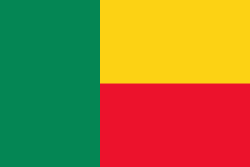Bantè (Commune of Bante)
Bantè is a town, arrondissement, and commune in western Benin. It is located in the former Zou Province of which since 1999 is part of the Collines Department. The commune covers an area of 2695 square kilometres and as of 2013 had a population of 106,945 people. The majority of the population is ethnically Nago specifically of the Isha subgroup, who themselves are a subgroup of the Yoruba. It is famous for the art exhibition Nago Hunters of the Bante Kingdom by Jean-Dominique Burton.
Settlements in the commune of Bantè include:
* Abidzi
Settlements in the commune of Bantè include:
* Abidzi
Map - Bantè (Commune of Bante)
Map
Country - Benin
 |
 |
| Flag of Benin | |
From the 17th to the 19th century, political entities in the area included the Kingdom of Dahomey, the city-state of Porto-Novo, and other states to the north. This region was referred to as the Slave Coast from the early 17th century due to the high number of people who were sold and trafficked during the Atlantic slave trade to the New World. France took over the territory in 1894, incorporating it into French West Africa as French Dahomey. In 1960, Dahomey gained full independence from France. As a sovereign state, Benin has had democratic governments, military coups, and military governments. A self-described Marxist–Leninist state called the People's Republic of Benin existed between 1975 and 1990. In 1991, it was replaced by the multi-party Republic of Benin.
Currency / Language
| ISO | Currency | Symbol | Significant figures |
|---|---|---|---|
| XOF | West African CFA franc | Fr | 0 |
| ISO | Language |
|---|---|
| FR | French language |















